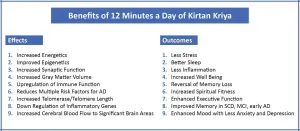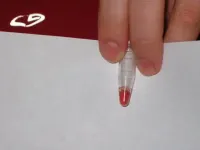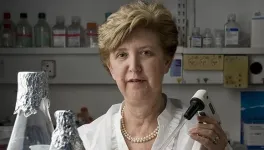(Press-News.org) Marie-Claude Bourgeois-Daigneault and her team at the CRCHUM are using mice to show how a combination of peptides and oncolytic viruses, used as an adjuvant, can provide effective immunization against cancer.
In her laboratoryat the University of Montreal Hospital Research Centre (CRCHUM), Marie-Claude Bourgeois-Daigneault and a team of scientists usually modify viruses to make them specific to the cells of a tumour.
Once in the patient's body, these viruses, called oncolytic viruses, infect and specifically destroy the cancer cells without touching healthy cells. These viruses can even stimulate the immune system so that it is better armed to recognize and kill malignant cells. This is immunotherapy.
In a study published in Nature Communications, the scientific team at the University of Montreal Hospital Research Centre (CRCHUM) show how they came to create an effective personalized vaccine by combining oncolytic viruses with small synthetic molecules (peptides) specific to the targeted cancer.
Bourgeois-Daigneault is a professor in Université de Montréal department of microbiology, infectious diseases and immunology), a member of the Institut du cancer de Montréal and the principal author of the study, led by Dominic Guy Roy.
Here, she explains her team's approach and findings.
In your study, you use oncolytic viruses as anti-cancer vaccine adjuvants to immunize mice. How do you do it?
For a vaccine to induce an immune response, it has to contain elements that stimulate the cells of the immune system--the famous white blood cells.
These elements, called adjuvants, are ingredients in all vaccines. They allow the human body to perceive potential danger and contain the threat by sending its army of immune cells.
Our approach consists of using oncolytic viruses to stimulate this immune response and direct it towards the cancer. To succeed, we create a vaccine by mixing viruses with synthetic peptides (antigens) that resemble the targeted cancer.
Because it's true that, to be effective, the vaccine has to be personalized for each patient, based on the mutations specific to each cancer cell. Thanks to the identification work done by other research teams, we can predict what peptides to use for each patient through the information obtained from a biopsy.
The advantage of our approach is that the oncolytic viruses themselves have the power to kill the cancer. We can thus attack the cancer on two fronts: kill it directly with the virus and induce an immune response, thanks not only to the virus, but to the vaccine as well.
On our mice, we were able to show the efficacy of the resulting immunization.
What sets your vaccine strategy apart from clinical trials currently being conducted by other teams?
The other clinically tested personalized anti-cancer vaccines don't use oncolytic viruses as vaccination adjuvants. Therefore, their adjuvant doesn't have direct anti-cancer effects whereas, in our case, our viruses can destroy the cancer.
An anti-cancer vaccine using oncolytic viruses is currently being tested in Canada and the U.S. However, it is not personalized. Instead, it targets certain specific cancers that have an antigen in common. By targeting this antigen, the vaccine induces an immune response.
In this case, the oncolytic viruses have to be genetically modified to allow for the insertion of the antigen into the genome of the viruses.
This is very different from our approach. We can target all cancers without genetic modification. A little like putting together Lego--it's a matter of mixing synthetic peptides resembling the cancer with the chosen virus. It will be a lot easier to implement in a clinical setting.
What challenges need to be addressed before your personalized anti-cancer vaccination approach can be translated to clinical practice?
The main challenge is to identify the mutations that we want to vaccinate against. Because a cancer is unique in its tens or hundreds of mutations, but only a few of them, once targeted, will have a therapeutic effect and allow us to eliminate it.
The identification of these mutations is the key step that still has to be optimized. Fortunately, many groups are working in this area.
INFORMATION:
About this study
"Adjuvant oncolytic virotherapy for personalized anti-cancer vaccination," by Dominic Guy Roy and his colleagues, was published May 11, 2021 in Nature Communications. The study was funded by the Canadian Institutes of Health Research, the Terry Fox Foundation, the Canadian Cancer Society Research Institute, the Ontario Institute for Cancer Research, the Ottawa Regional Cancer Foundation, the Ottawa Hospital Foundation, BioCanRx, the Alliance for Cancer Gene Therapy, the Institut du cancer de Montréal, the Fonds de recherche Québec-Santé and the Quebec Breast Cancer Foundation.
About the CRCHUM
The University of Montreal Hospital Research Centre (CRCHUM) is one of North America's leading hospital research centres. It strives to improve adult health through a research continuum covering such disciplines as the fundamental sciences, clinical research and public health. Over 1,850 people work at the CRCHUM, including more than 550 researchers and more than 460 graduate students. chumontreal.qc.ca/crchum
@CRCHUM
About l'Université de Montréal
Deeply rooted in Montreal and dedicated to its international mission, Université de Montréal is one of the top universities in the French-speaking world. Founded in 1878, Université de Montréal today has 13 faculties and schools, and together with its two affiliated schools, HEC Montréal and Polytechnique Montréal, constitutes the largest centre of higher education and research in Québec and one of the major centres in North America. It brings together 2,400 professors and researchers and has more than 67,000 students. umontreal.ca
NEW YORK (May 11, 2021) - A group of scientists say now is the time to talk about reintroducing jaguars (Panthera onca) into the U.S.
In a study published today in the journal Conservation Science and Practice, the authors provide a prospective framework for this effort and describe "righting a wrong" done to "America's Great Cat" in the Southwest more than 50 years ago. The big cats lived for hundreds of years in the central mountains of Arizona and New Mexico but were driven to local extinction by the mid-20th century, in part because of killing by government hunters.
Authors of the study include a diverse set ...
Amsterdam, May 11, 2021 - It is projected that up to 152 million people worldwide will be living with Alzheimer's disease (AD) by 2050. To date there are no drugs that have a substantial positive impact on either the prevention or reversal of cognitive decline. A growing body of evidence finds that targeting lifestyle and vascular risk factors have a beneficial effect on overall cognitive performance. A new review in the Journal of Alzheimer's Disease, published by IOS Press, examines research that finds spiritual fitness, a new concept in medicine that centers on psychological and spiritual wellbeing, and Kirtan Kriya, a simple 12-minute meditative practice, may reduce multiple risk factors for AD.
"The key point of this review is that making a commitment ...
DNA is composed of nucleobases represented by the letters A, T, G and C. They form the basis of the genetic code and are present in all living beings. But in a bacteriophage, another base, represented by the letter Z, exists. This exception, the only one observed to date, has long remained a mystery. Scientists from the Institut Pasteur and the CNRS, in collaboration with the CEA, have now elucidated the biosynthesis pathway of this base. This work has been published in the April 30th, 2021 issue of Science.
DNA, or deoxyribonucleic acid, is a molecule ...
Study Take-Aways:
Different African populations were genetically interrelated suggesting abundant gene flow across Africa such that all African population should be considered together as single subspecies.
There appeared a striking genomic distance between leopards living in Asia vs. leopards in Africa.
Asian leopards are more genetically separated from African leopards than brown bear species are from polar bear species, the researchers found.
The two leopard groups actually diverged around the same time as Neanderthals split apart from modern humans.
The genetic differences between African and Asian leopards have been maintained ...
It took an unlikely food innovation -- earth-friendly vegetarian patties, made to taste and "bleed" like the familiar meaty ones -- to make people aware of heme.
But heme is an essential part of proteins found in most life forms, from tiny bacteria to soy plants to the human body. Heme plays a crucial role in supplying cells with the energy needed to carry out chemical reactions.
In human cells, iron-containing heme is the essential cofactor of two types of molecules. One is the hemoglobin molecules that bind oxygen in the lungs and ferry it around the body. More than half ...
ALBUQUERQUE, N.M. -- Two groups of researchers at Sandia National Laboratories have published papers on the droplets of liquid sprayed by coughs or sneezes and how far they can travel under different conditions.
Both teams used Sandia's decades of experience with advanced computer simulations studying how liquids and gases move for its nuclear stockpile stewardship mission.
Their findings reinforce the importance of wearing masks, maintaining social distancing, avoiding poorly ventilated indoor spaces and washing your hands frequently, especially with ...
Trinity study finds people homeless in their 20s, 30s and 40s are physically comparable to those housed in their 70s and 80s
A Trinity College study published today (Monday, 10th May 2021) demonstrates an extremely high burden of physical and mobility problems experienced by people who are homeless and were admitted for inpatient care to an acute hospital in Dublin. The study found that only one third of participants could climb a hospital stairs and there was a very common presentation of geriatric conditions such as frailty, falls and needing a mobility aid on a long term basis, despite a low median participant age of 45 years.
The study is published in the journal Scientific Reports here: http://www.nature.com/articles/s41598-021-88590-0
Overall ...
Dental and orthopedic implants are widely used around the world. Common causes for implant failure are the immune response against oral bacteria and titanium particles shed by the implant. These and other phenomena can generate an inflammatory response, activating the osteoclasts (bone resorbing cells), and ultimately leading to osteolysis (destruction of bone tissue) around the implants. After this process begins, it is almost impossible to control, eventually leading to loss of the implant. A similar process occurs around natural teeth, with bacteria as the main cause, and bone resorption triggered by the immune response and inflammatory cells.
Researchers from Tel Aviv University have developed ...
LAWRENCE -- The COVID-19 pandemic has presented a new world of challenges for education. But a new study from the University of Kansas shows the voices and experiences of students who are already among the most marginalized can help lead the way in making young people's strengths the focus of education.
Students with disabilities already faced a disproportionate amount of inequities in the American educational system before the pandemic. Researchers interviewed students in this population about their experiences during the pandemic and found that students relied on their own strengths, resilience and self-determination. The findings not only highlight the importance ...
Extreme weather is harming UK agriculture - but many farmers have not yet made adapting to the effects of the climate emergency a priority, a new study shows.
All farmers who took part in the research said they had experienced or witnessed issues caused by extreme weather such as heavy rain or prolonged dry spells in recent years, and expected these to intensify further.
Many were concerned about the impact of heat and drought on crop and grass growth, with knock-on impacts for yield and winter animal feed, and the implications of heavy rainfall/flooding for soil run-off and erosion and for field operations such as drilling and harvesting. ...



